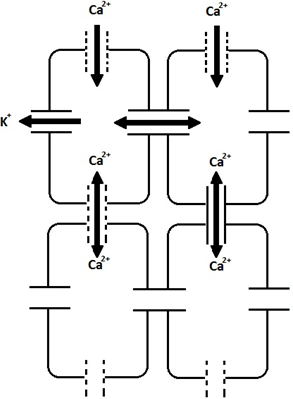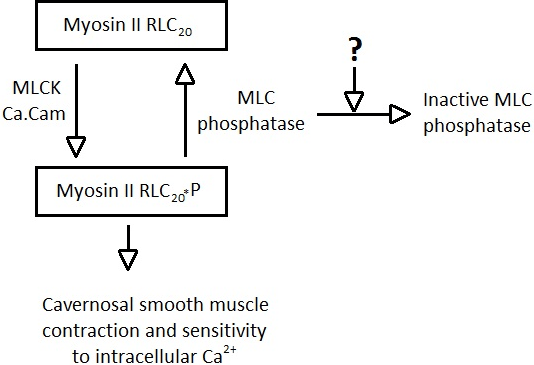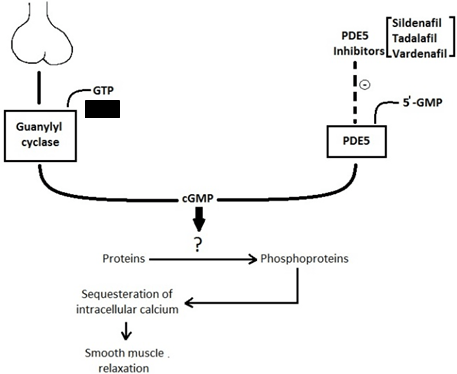This set of Molecular Endocrinology Multiple Choice Questions & Answers (MCQs) focuses on “Human Sexual Response Cycle and Physiologic Mechanisms”.
1. During the sexual arousal phase of genital stimulation, women displayed more activation in which region?
a) Left frontoparietal area
b) Right frontoparietal areas
c) Middle lobe of lumen
d) Palatal muscles
View Answer
Explanation: The men displayed greater activation in certain brain regions, including the hypothalamus, when viewing sexually graphic sets of images than the women did. In other research, during the process of sexual excitement genital stimulation showed more activation in the left frontoparietal areas in women.
2. Which among the following drugs are sexually inhibiting and independent of their inhibitory effect on luteinizing hormone (LH), LH-releasing hormone, and testosterone?
a) Endogenous opiates
b) Exogenous opiates
c) Exogenous heroine
d) Endogenous zinetcsea
View Answer
Explanation: Exogenous opiates, irrespective of their inhibitory effect on luteinizing hormone (LH), LH-releasing hormone and testosterone, are sexually inhibitory in their effect. Endogenous opioids modulate the hypothalamus and pituitary feedback effects of sex steroids.
3. What is the test used to detect genital congestion in humans?
a) Ovarian photoplethysmography (OPP)
b) Fallopian photoplethysmography (FPP)
c) Vaginal photoplethysmography (VPP)
d) Clitoral photoplethysmography (CPP)
View Answer
Explanation: As measured by vaginal photoplethysmography (VPP), young women show marked genital congestion, while no genital response is reported in males. Similarly, heterosexual women who see lesbian women engaging in sexual activity report modest subjective enthusiasm, but display a prompt vasocongestive reaction.
4. In general, men exhibit greater responsiveness to sexually stimulating sensory elements than women do.
a) True
b) False
View Answer
Explanation: Men typically exhibit greater responsiveness to visual sexually arousing stimuli than women do. Men displayed substantially greater activation in the amygdala than women, when men and women saw couples engaging in nonsexual ways, but the women scored their enthusiasm higher.
5. Three processes compose the ejaculatory mechanisms in men: emission, ejection, and orgasm.
a) True
b) False
View Answer
Explanation: Three processes compose the ejaculatory mechanisms: emission, ejection, and orgasm. While orgasm and seminal fluid ejection frequently occur simultaneously, different mechanisms control these two processes. Emission, depending on the consistency of the vasa deferentia, seminal vesicles, prostate gland, and bladder neck, is the deposition of the seminal fluid into the posterior urethra.
6. Which is the ventrally placed erectile tissue of the penis during sexual arousal?
a) Corpora cavernosa
b) Corpus spongiosum
c) Corpora luteus
d) Corpus labiosum
View Answer
Explanation: Two dorsally located corpora cavernosa and a ventrally situated corpus spongiosum make up the erectile tissue of the penis. Numerous cavernous areas are divided by trabeculae contain the erectile tissue of both the corpora cavernosa and the corpus spongiosum.
7. The penile arterial blood supply is derived from which among the following arteries?
a) Pudendal arteries
b) Labial arteries
c) Amidic arteries
d) Idiophonic arteries
View Answer
Explanation: The supply of penile arterial blood is derived from pudendal arteries, which are internal iliac artery branches. The pudendal artery is divided into the arteries of the cavernosum, dorsal penile, and bulbourethral. For the corpora cavernosa, the cavernosal arteries and their branches, the helicine arteries, provide blood supply.
8. In the diagram given below showing the calcium reflux of the cavernosal smooth muscle cells contain, which among the following gap junctions?

a) Mallenin99-derived gap junction
b) Bakexin78-derived gap junction
c) Valexin59-derived gap junction
d) Connexin43-derived gap junction
View Answer
Explanation: Connexin43-derived gap junction is the gap junction that is present in the calcium reflux of the cavernosal smooth muscle cells. A number of cellular processes that include potassium (K+) flux through potassium channels, connexin43-derived gap junctions, and a number of cholinergic, adrenergic, and noradrenergic noncholinergic mediators monitor the transmembrane and intracellular calcium flux in the cavernosal smooth muscle cells.
9. Among the potassium channels present in the cavernosal smooth muscle cells, which one is most important?
a) BKCa
b) KATP
c) Kv
d) LBK
View Answer
Explanation: At least three types of potassium channels are expressed in cavernosal smooth muscle cells, which include KATP, Kv, and calcium-sensitive K+ channels, referred to as BKCa or maxi-K channels. Of these, the most important are the BKCa channels, since they account for 90% of the cavernosal smooth muscle cells’ K+ efflux.
10. In the given diagram showing, regulation of cavernosal smooth muscle sensitivity to intracellular calcium, which is the enzyme present in the step marked?

a) Protein kinase A
b) Rho kinase
c) Cholesterol esterase
d) Lyase isomerase I
View Answer
Explanation: Calcium sensitivity and smooth muscle contractility are regulated by the kinase system of Rho A/Rho. A significant determinant of smooth muscle sensitization to Ca2+ is the equilibrium between the phosphorylation (P) of myosin regulatory light-chain (Myosin II RLC20) kinase and its dephosphorylation by myosin light-chain phosphatase.
11. Which is the enzyme that is specific to the NO/cGMP pathway in the corpora cavernosa?
a) Phosphodiesterase 5
b) Protein kinase C
c) Protein kinase 3
d) Phosphatidyl ester amine 3
View Answer
Explanation: Only phosphodiesterase 5 (PDE5) in corpora cavernosa is unique to the NO/cGMP pathway. Hydrolysis of cGMP by this enzyme contributes to smooth muscle relaxation reversal and penile erection reversal.
12. Diagram given below shows the Regulation of cavernosal smooth muscle relaxation by nitric oxide (NO). Here, which enzyme regulates cavernosal smooth muscle relaxation?

a) Cyclic guanosine monophosphate (cGMP) dependent kinases
b) Phosphodiesterase A
c) Cyclic Adenosine monophosphate (cAMP) dependent kinases
d) Erythrolein kinases
View Answer
Explanation: NO is released from noradrenergic nor cholinergic nerve endings and also from the endothelium. NO activates guanylyl cyclase, which produces guanosine triphosphate (GTP) cGMP, which in turn activates cGMP-dependent kinases, resulting in intracellular calcium sequestration and relaxation of smooth muscles.
13. Which among the following enzymes, hydrolyze cAMP and cGMP, thereby reducing their concentrations within the cavernosal smooth muscle?
a) Cyclic Nucleotide Phosphodiesterases
b) Cyclic guanosine monophosphate (cGMP) dependent kinases
c) Cyclic Adenosine monophosphate (cAMP) dependent kinases
d) Phosphodiesterase A
View Answer
Explanation: Hydrolysis of the second messengers, cyclic AMP and cyclic GMP, reducing their concentrations within the smooth muscle of the cavernosa is carried out by Phosphodiesterases of cyclin nucleotides. They also have major roles in maintaining homeostasis and signal transduction in human beings.
14. Which phosphodiesterase is specific to the NO/cGMP pathway in the corpora cavernosa?
a) Phosphodiesterase 5 (PDE5)
b) Phosphodiesterase 9 (PDE9)
c) Phosphodiesterase 11 (PDE11)
d) Phosphodiesterase 55 (PDE55)
View Answer
Explanation: Only phosphodiesterase 5 (PDE5) in corpora cavernosa is unique to the NO/cGMP pathway. Hydrolysis of cGMP by this enzyme contributes to smooth muscle relaxation reversal and penile erection reversal.
15. Which among the following is an example of the selective inhibitors of the activity of PDE5?
a) Sildenafil
b) Declonac
c) Filnac
d) Belnikap
View Answer
Explanation: Sildenafil, vardenafil, and tadalafil are active and selective PDE5 activity inhibitors; they avoid cGMP breakdown and thereby improve penile erection. Sildenafil is a drug specifically used to treat erectile dysfunction and pulmonary arterial hypertension, marketed under the brand name Viagra, among others.
Sanfoundry Global Education & Learning Series – Molecular Endocrinology.
To practice all areas of Molecular Endocrinology, here is complete set of 1000+ Multiple Choice Questions and Answers.
If you find a mistake in question / option / answer, kindly take a screenshot and email to [email protected]
